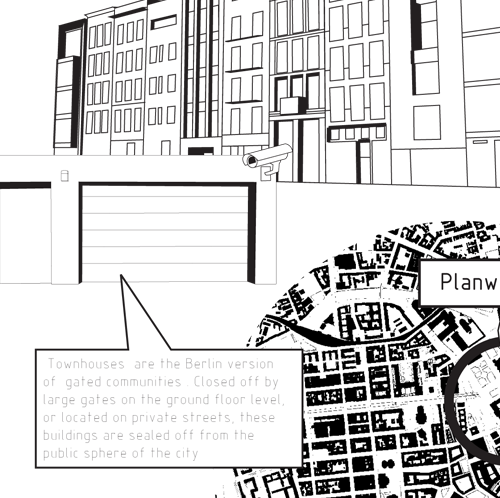"Berlinish" Architecture
by fzz.cc
1. Poster
nationalism and architecture
For everyone who has wondered why Berlin looks like how it looks like today and anyone interested in the planning debate in Berlin we have designed a poster with info-graphics summing up the positions of the major actors that have shaped the planning discourse during the past 20 years.
It explains what supposedly "Berlinish" architecture should look like and why hardly any foreign architects have realised major projects in Berlin during the last 15 years. It stages mainly the protagonists, as the critique has been rather weak and marginal during recent years. Furthermore, many critics of the past have become protagonists of today, while maintaining their self-perception as critical actors, propagating a citizen friendly and ecological city. A consensus from the political left to the right wants to re-establish the historic city lost in the 2nd world war, culminating in the re-erection of a Prussian castle (the Stadtschloss) in the middle of the city. For that purpose, a modernist multi-purpose building (the Palast der Republik), erected in the seventies by the German Democratic Republic on the site of the former Stadtschloss, whose remains were blown up in 1950, was dismantled during the past two years.
Schloss
Voted for by the parliament, the facades of the Stadtschloss will be erected to encase a new public cultural institution, the so-called "Humboldt Forum." combining a new city library, scientific collections from the Humboldt University and, the largest part, an ethnological collection which is currently shown in the West-Berlin district of Dahlem. A perfect scandal: a colonial collection behind a Prussian facade as an ID-card for cosmopolitanism.
Architecture often serves as a signifier for desired models of society. What has been going on in Berlin has to be understood in the context of a post unified Germany, gaining back full sovereignty after 1990 . Following re-unification the parliament voted to make Berlin the capital city once again. The process of reconstructing the image of Germany (from the Bonner Republik to the Berliner Republik) was marked by several infringements of taboos, re-allowing a positive identification with authoritarian values like austerity, clarity, straightness or solidity in the ideological set of "Germanness." This process was paralleled by the forming identity of a new, responsible Germany, which has critically self-reflected come to past. The protest generation of 1968 has arrived into positions of power maintaining their "anti-fascist" self-perception while building a new national(ist) brand based on that self-perception. The re-establishment of nationalism through the back door (based on the "excellent" German job of coming to terms with one’s own history) was welcomed by the conservative right and facilitated a national consensus that it is OK again to feel proud about ones (German) nationality. The new Stadtschloss is a perfect image of this consensus. Prussia and the monarchy is being rehabilitated as a positive source of identity and merged with a new, responsible, cultured and worldly self-perception.
2. Berlin Townhouses
by Robert Burghardt
A slide-show about the Friedrichserder Townhouse development
The townhouse is a relatively new marketing model for real estate, but above all it is a signifier for a new image of Berlin. In the past years, the concept of the townhouse has been the role-model for the transformation of the centre of Berlin. Currently, proposals are circulating to build townhouses on the vast open spaces under the television tower.
Central to the propagation of townhouses is an intentional misunderstanding, which is actually rooted in the German language. The German translation of the townhouse would a "Stadthaus", but more correct, a "Bürgerhaus". The term "Bürger" means two things; it signifies the bourgeois and bourgeois culture, as well as the citizen. While the former is an exclusionist class-model, is the latter a universal democratic concept.
Townhouses are being proposed as the ideal solution for many open sites, remaining in the centre of Berlin. They are the counter model to modernist city planning of large mono-functional slabs with large green spaces in between which have been criticized as inhuman, boring and foremost anti-urban. Townhouses should now re-vitalize central areas of Berlin by bringing back a plural and differentiated structure based on the historical, pre-war street patterns. The townhouse is identified as an ecological and democratic model: The townhouse offers families an alternative in the city centre to moving to large houses with gardens in the suburbs, it makes more efficient use of the urban infrastructure and, this is the ideological hinge, it allows for the "Bürger" to take control of its city centre again, to express him- or herself through a building.
Townhouses are extremely expensive real-estate for very few, constructed on former public, open spaces. The pluralism, which is suggested through their differentiated facades is a mere monotony. Townhouses add less to the urbanity of Berlin than parks: they are closed-off gated communities, removed from the street through garages on the ground floor and surveilled by CCTV.
The development on Friedrichswerder has been declared as a role model by the department of urban development by the city council. Other townhouse projects in central districts like Mitte or Prenzlauer Berg are on their way, some of them have gated, private streets, in the middle of those neighborhoods whose “urbanity” (quirky and lively street life in a traditional urban fabric) has been praised.

